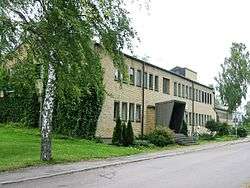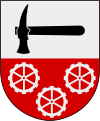Hallstahammar Municipality
Hallstahammar Municipality (Hallstahammars kommun) is a municipality in Västmanland County in central Sweden. Its seat is located in the town of Hallstahammar.
Hallstahammar Municipality Hallstahammars kommun | |
|---|---|
 Hallstahammar Town Hall | |
 Coat of arms | |
 | |
| Country | Sweden |
| County | Västmanland County |
| Seat | Hallstahammar |
| Area | |
| • Total | 180.134024 km2 (69.550135 sq mi) |
| • Land | 169.574024 km2 (65.472897 sq mi) |
| • Water | 10.56 km2 (4.08 sq mi) |
| Area as of 1 January 2014. | |
| Population (31 December 2019)[2] | |
| • Total | 16,346 |
| • Density | 91/km2 (240/sq mi) |
| Time zone | UTC+1 (CET) |
| • Summer (DST) | UTC+2 (CEST) |
| ISO 3166 code | SE |
| Province | Västmanland |
| Municipal code | 1961 |
| Website | www.hallstahammar.se |
In 1971 "old" Hallstahammar (with the status of a köping since 1943) was amalgamated with parts of the dissolved Kolbäck rural municipality to form the present municipality of unitary type.
The municipal slogan is "Bo hos oss/Live with us", which reflects the ambition of the present municipal leadership to boost population figures.
Geography
The municipality is subdivided into two parishes: Hallstahammar-Berg and Kolbäck-Säby. They are distinctive from each other: Hallstahammar-Berg in the north is situated along forest lands; Kolbäck-Säby in the south is a centre of communications by roads and railways as well as the intersecting river. Strömsholm, in the southern part of Kolbäck, borders to Lake Mälaren and has open fields around its Royal Castle.
Communications
With train it takes 10 minutes to central Västerås (a larger city), and about an hour to the Central Station of Stockholm. It is also possible to travel straight south, passing the bridge over Lake Mälaren to the larger city Eskilstuna. Good car transport is provided by European route E18 that passes between Kolbäck and Hallstahammar.
Notability
One of Sweden's foremost riding gymnasiums is located in Strömsholm, as part of the Kantzowska Gymnasium. The Church of Kolbäck goes back to the 13th century and has interior decorations paid for by Queen Hedvig Eleonora in the 17th century. The Church of Säby was beautifully restored in the 1630s.
References
- "Statistiska centralbyrån, Kommunarealer den 1 januari 2014" (in Swedish). Statistics Sweden. 2014-01-01. Archived from the original (Microsoft Excel) on 2016-09-27. Retrieved 2014-04-18.
- "Folkmängd i riket, län och kommuner 31 december 2019" (in Swedish). Statistics Sweden. February 20, 2020. Retrieved February 20, 2020.
External links
- Hallstahammar Municipality - Official site